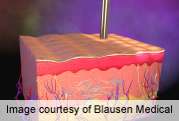In ablative fractionated carbon-dioxide laser treatment for photoaging, cold-air anesthesia used in conjunction with topical anesthesia reduces pain significantly more than topical anesthesia alone, according to research published online June 13 in the Journal of the American Academy of Dermatology.
(HealthDay) -- In ablative fractionated carbon-dioxide (CO2) laser treatment for photoaging, cold-air anesthesia used in conjunction with topical anesthesia reduces pain significantly more than topical anesthesia alone, according to research published online June 13 in the Journal of the American Academy of Dermatology.
Emily P. Tierney, M.D., of the Tufts University School of Medicine in Boston, and C. William Hanke, M.D., M.P.H., of St. Vincent Hospital in Carmel, Ind., conducted a prospective split-face study involving 15 patients undergoing ablative fractionated CO2 laser treatment for photoaging. Patients and physicians rated the perceived discomfort of the treatment on each side of the face to assess whether forced cold-air anesthesia could reduce the discomfort of the laser procedure.
The researchers found that the mean patient-reported pain score was statistically significantly lower with cold-air anesthesia and topical anesthesia, at 4.27 (on a scale from 0 to 10) compared with 7.47 for topical anesthesia alone. The mean physician-reported scores were similar, at 3.73 for cold-air anesthesia and topical anesthesia compared with 7.8 for topical anesthesia alone (P < 0.01).
"The anesthetic use of forced cold air in conjunction with ablative fractionated CO2 laser is a practical, well-tolerated modality that allows performance of the procedure with minimal discomfort in the absence of sedation, anesthesia, and narcotic analgesia," the authors write.
More information:
Abstract
Full Text (subscription or payment may be required)
Journal information: Journal of the American Academy of Dermatology
Copyright © 2012 HealthDay. All rights reserved.


















